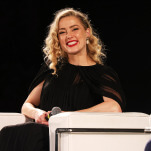Here Are the Unretouched Images From Lena Dunham's Vogue Shoot
LatestLena Dunham and her fans, ourselves included, love her just the way she is. Vogue‘s opinion, of course, is another matter.
Within two hours of offering $10,000 for unretouched images from Annie Leibovitz’s photography session with the HBO star, we received six allegedly unaltered images. As expected, they’re great — Lena looks fantastic. Aside from the obvious lighting tweaks that any publication would make, the unretouched images are pretty perfect. Which makes some of the adjustments — slightly narrowing a jaw or raising a waistline — seem that much more unnecessary. Why bother? These slight tweaks, the “you look great, but you’d look just a little more great if…” stuff is insidious.
But this is what Vogue does, and it’s interesting to see what Leibovitz and editor-in-chief Anna Wintour felt that they needed to “fix” before pictures of Lena could be presented to readers.
This tub photo has the most changes. The tweaks include:
- Shoulder/back of neck shaved down, lengthening the neck
- Line near mouth on face removed
- Jawline sharpened
- Neckline of dress pulled up — cleavage altered, armpit covered
- Waist/hip smoothed, made narrower
- Elbow shadow/dimple removed
- Hands smoothed
While Adam Driver’s leg was raised to come up out of the water, his face and body were untouched; the dog was also allowed to appear in Vogue without being altered.
This shot of Dunham at a subway station in Brooklyn only has minor alterations.
-

-

-

-

-

-

-

-

-

-

-

-

-

-

-

-

-

-

-

-

-

-

-

-

-

-

-

-

-

-

-

-

-

-

-

-

-

-

-

-








































